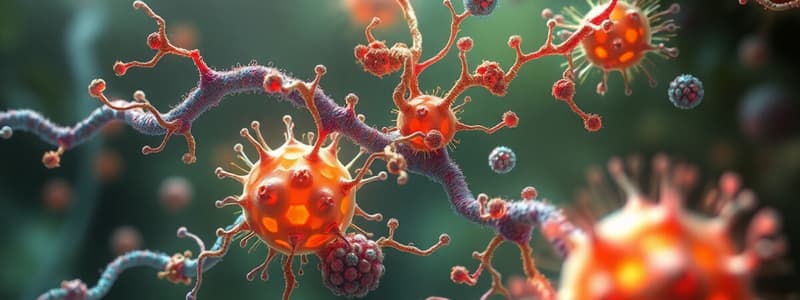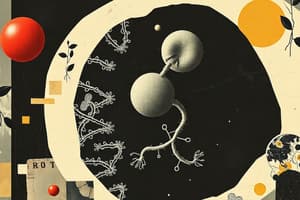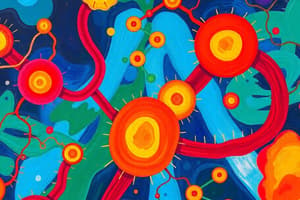Podcast
Questions and Answers
How do enzymes increase the rate of a reaction?
How do enzymes increase the rate of a reaction?
- Increasing the activation energy.
- Increasing the energy of the reactants.
- Lowering the activation energy. (correct)
- Increasing the reaction temperature.
What is the primary role of ATP in cellular metabolism?
What is the primary role of ATP in cellular metabolism?
- To provide energy for anabolic reactions. (correct)
- To catalyze metabolic reactions.
- To transport molecules across cell membranes.
- To store genetic information.
What role does lysozyme play in bacterial defense?
What role does lysozyme play in bacterial defense?
- It facilitates bacterial reproduction.
- It strengthens the bacterial cell wall.
- It targets and breaks down peptidoglycan, leading to cell lysis. (correct)
- It transports nutrients into the bacterial cell.
How does allosteric inhibition affect enzyme activity?
How does allosteric inhibition affect enzyme activity?
Why is the regeneration of NAD+ essential during fermentation?
Why is the regeneration of NAD+ essential during fermentation?
Which of the following is the MOST accurate description of catabolism?
Which of the following is the MOST accurate description of catabolism?
How do competitive inhibitors affect enzyme-catalyzed reactions?
How do competitive inhibitors affect enzyme-catalyzed reactions?
In cellular metabolism, what determines the specificity of an enzymatic reaction?
In cellular metabolism, what determines the specificity of an enzymatic reaction?
How does temperature affect enzyme activity?
How does temperature affect enzyme activity?
What is the ultimate fate of pyruvate under aerobic conditions in cellular respiration?
What is the ultimate fate of pyruvate under aerobic conditions in cellular respiration?
What role do electron carriers such as NADH and FADH2 play in the electron transport chain?
What role do electron carriers such as NADH and FADH2 play in the electron transport chain?
What is the key difference between aerobic and anaerobic respiration?
What is the key difference between aerobic and anaerobic respiration?
Which of the following is the MOST accurate description of the tricarboxylic acid (TCA) cycle?
Which of the following is the MOST accurate description of the tricarboxylic acid (TCA) cycle?
What is the primary difference between fermentation and cellular respiration?
What is the primary difference between fermentation and cellular respiration?
Which of the following metabolic processes occurs in the cytosol of bacterial cells?
Which of the following metabolic processes occurs in the cytosol of bacterial cells?
How do different microorganisms produce a variety of fermentation end products from the same initial substrate (e.g., glucose)?
How do different microorganisms produce a variety of fermentation end products from the same initial substrate (e.g., glucose)?
If a bacterial species ferments glucose but not lactose, which of the following can be accurately concluded?
If a bacterial species ferments glucose but not lactose, which of the following can be accurately concluded?
Why is ATP considered the 'energy currency' of the cell?
Why is ATP considered the 'energy currency' of the cell?
Which statement accurately describes ATP production via substrate-level phosphorylation?
Which statement accurately describes ATP production via substrate-level phosphorylation?
How does the configuration of particles influence a reaction?
How does the configuration of particles influence a reaction?
Which of the following chemical equations represents an enzymatic reaction where sucrose is broken down into glucose and fructose?
Which of the following chemical equations represents an enzymatic reaction where sucrose is broken down into glucose and fructose?
How many net ATP molecules are produced during glycolysis from one molecule of glucose?
How many net ATP molecules are produced during glycolysis from one molecule of glucose?
Which environmental factor does NOT directly influence enzyme activity?
Which environmental factor does NOT directly influence enzyme activity?
During what stage of cellular respiration is the majority of ATP generated?
During what stage of cellular respiration is the majority of ATP generated?
Which of the following best describes the relationship between anabolic and catabolic reactions?
Which of the following best describes the relationship between anabolic and catabolic reactions?
What is the function of ligases during enzymatic reactions?
What is the function of ligases during enzymatic reactions?
During the TCA cycle, how many NADH molecules are produced from each molecule of acetyl-CoA that enters?
During the TCA cycle, how many NADH molecules are produced from each molecule of acetyl-CoA that enters?
If a substance prevents an enzyme from carrying out its function, what is the substance called?
If a substance prevents an enzyme from carrying out its function, what is the substance called?
Flashcards
Metabolism
Metabolism
The collection of controlled biochemical reactions within cells, converting 'food' into energy for life processes.
Catabolic Reaction
Catabolic Reaction
Reactions that break down complex molecules into simpler ones, releasing energy.
Anabolic Reaction
Anabolic Reaction
Reactions that synthesize complex molecules from simpler ones, using energy.
ATP (Adenosine Triphosphate)
ATP (Adenosine Triphosphate)
Signup and view all the flashcards
Enzymes
Enzymes
Signup and view all the flashcards
Hydrolases
Hydrolases
Signup and view all the flashcards
Isomerases
Isomerases
Signup and view all the flashcards
Ligases/Polymerases
Ligases/Polymerases
Signup and view all the flashcards
Lyases
Lyases
Signup and view all the flashcards
Oxidoreductases
Oxidoreductases
Signup and view all the flashcards
Transferases
Transferases
Signup and view all the flashcards
Enzyme Inhibitors
Enzyme Inhibitors
Signup and view all the flashcards
Competitive Inhibitors
Competitive Inhibitors
Signup and view all the flashcards
Allosteric Site
Allosteric Site
Signup and view all the flashcards
Lysozyme
Lysozyme
Signup and view all the flashcards
Carbohydrates
Carbohydrates
Signup and view all the flashcards
Carbohydrate Catabolism
Carbohydrate Catabolism
Signup and view all the flashcards
Cellular Respiration
Cellular Respiration
Signup and view all the flashcards
Fermentation
Fermentation
Signup and view all the flashcards
Glycolysis
Glycolysis
Signup and view all the flashcards
TCA cycle
TCA cycle
Signup and view all the flashcards
Electron Transport Chain
Electron Transport Chain
Signup and view all the flashcards
ATP from 1 Glucose
ATP from 1 Glucose
Signup and view all the flashcards
Concentration gradient
Concentration gradient
Signup and view all the flashcards
Anaerobic Respiration
Anaerobic Respiration
Signup and view all the flashcards
Aerobic Respiration
Aerobic Respiration
Signup and view all the flashcards
Fermentation
Fermentation
Signup and view all the flashcards
Fermentation tests
Fermentation tests
Signup and view all the flashcards
Study Notes
Microbial Metabolism
- Microbial metabolism refers to the complete set of controlled biochemical reactions that occur within microbial cells.
- These reactions enable organisms to convert "food" into energy for survival and facilitate various life processes.
Metabolism
- Metabolism encompasses all the complex, controlled biochemical reactions within an organism's cells. Organisms use metabolism to convert food into energy for life.
- Metabolic reactions drive essential life processes such as photosynthesis, respiration, reproduction, growth, and movement.
- Energy is required to facilitate the energy-making process, some reactions generate energy while others consume it.
Overview of Metabolism
- Catabolic reactions break down complex molecules into simpler ones, releasing energy in the process.
- Anabolic reactions synthesize complex molecules from simpler ones and require energy input.
- Energy released from catabolic reactions is used in anabolic reactions.
ATP: The Currency of the Cell
- Adenosine triphosphate (ATP) is a "high-energy" molecule that readily provides energy to drive anabolic reactions. Energy from catabolic reactions is stored in ATP.
Enzymes
- Enzymes are crucial proteins that facilitate metabolic reactions by acting as catalysts. They efficiently accelerate the rate of chemical reactions
- Enzymes convert substrates into products through highly specific enzymatic reactions such as sucrose converting to glucose and fructose when catalyzed by sucrase.
- Different cells use different sets of enzymes, depending on their genetic makeup for example, Proteus, uses urease.
Naming and Classifying Enzymes
- Enzymes are classified into categories such as Hydrolases, Isomerases, Ligases or polymerases, Lyases, Oxidoreductases, and Transferases
Importance of Enzymes in Reactions
- Atoms, ions, or molecules must collide for a reaction to occur, and this is determined by speed, configuration of particles, reaction energy required, temp, and pressure etc.
- Normal physiological temperature and pressure are too low for reactions to occur at a life-maintaining rate, an increased temp or pressure would kill the organism
How Do Enzymes Work?
- Enzymes facilitate catabolic (breakdown) reactions, the breakdown of bonds requires energy.
- Some enzymes can also induce anabolic reactions by bringing reactants together
Factors Influencing Enzyme Activity
- Enzyme activity is impacted by temperature, each enzyme has it's own optimum temperature.
- Enzyme activity is impacted by pH levels, each enzyme has it's optimum pH.
- Substrate concentration affects enzyme activity, enzymes can become saturated
Inhibitors Influence Enzyme Activity
- Enzymes can be controlled by inhibitors, substances that affect the enzyme's ability to function
- Competitive inhibitors bind to the active site of an enzyme, thus competing with the intended substrate. This process can be either reversible or irreversible.
Allosteric Molecules Influence Enzyme Activity
- The allosteric site is distinct from the active site
- Binding of an allosteric molecule causes distortion of the active site
- There are allosteric inhibitors and allosteric activators
Lysozyme
- Lysozyme breaks glycosidic bonds in peptidoglycan, disrupting bacterial cell walls, facilitating bacterial cell death.
- Lysozyme can be found in animal secretions like tears, saliva and other bodily fluids
- It serves as a crucial defense against bacteria.
Carbohydrate Catabolism
- Carbohydrates serve as the primary energy source, encompassing sugars like glucose, mannose, fructose, and sucrose
- Energy from glucose is generated through 2 processes: Cellular respiration may be aerobic or anaerobic. Fermentation does not require oxygen
- Glycolysis begins both of these methods
Metabolic Pathway: Glycolysis
- Glycolysis is a sequence of reactions that degrades glucose into pyruvate with a small net gain of ATP;
- Glycolysis operates anaerobically, important in organisms that ferment sugars, is utilized by yeast to find alcohol in beer, and acts as a source to make other compounds
- In bacteria, glycolysis takes place in the cytosol
Energy-Investment Stage
- Step 1: Glucose is phosphorylated by ATP, resulting in the formation of glucose-6-phosphate
- Step 2 and 3: Atoms of glucose-6-phosphate restructure to produce fructose-6-phosphate, this is then phosphorylated with ATP to form fructose-1,6-bisphosphate.
Lysis Stage
- Step 4: Fructose-1,6-bisphosphate cleaves into glyceraldehyde-3-phosphate (G3P) and dihydroxyacetone phosphate (DHAP).
- Step 5: DHAP isomerizes into another molecule of G3P.
Energy-Conserving Stage
- Step 6: Inorganic phosphates join the two G3P molecules, and two molecules of NAD+ are reduced.
- Step 7: Two ADP molecules get phosphorylated. This process of phosphorylation is at its substrate level and produces two ATP.
- Steps 8 & 9: The remaining phosphates migrate toward the middle carbons and a water molecule is taken from each substrate.
- Step 10: Two ADP are phosphorylated, resulting in two ATP molecules and two pyruvic acid molecules.
Continuation of Cellular Respiration
- Pyruvate can undergo aerobic degradation through the TCA cycle, generating more ATP. Pyruvate is completely oxidized in a series of redox reactions to produce ATP.
- Cellular respiration proceeds in three stages: Synthesis of acetyl-CoA, TCA cycle (tricarboxylic acid cycle), and Electron transport chain: final series of redox reactions.
Formation of Acetyl Co-A
- Coenzyme A combines with acetate
TCA Cycle (Citric Acid Cycle/Krebs Cycle)
- In one cycle, two carbons enter as Acetyl-CoA, and two different carbons are released as CO2.
- Four redox reactions generate three NADH and one FADH2 molecule.
- One high-energy phosphate bond is created in the form of GTP.
Three Stages of Cellular Respiration
- The starting material/glucose is completely broken down to generate ATP.
- In Glycolysis: Glucose converts to pyruvate, using 2 ATP and producing 2 NADH.
- Synthesis of Acetyl-CoA requires 2 NADH and releases 2 CO2
- The TCA Cycle: 2 Acetyl-CoA form 4 CO2, 2 GTP, 6 NADH, and 2 FADH2.
- The Electron Transport Chain uses electrons from NADH and FADH2 to produce ATP.
- Highly Efficient: 38 ATP generated from each glucose molecule
Summary Ideal Prokaryotic Aerobic Respiration
- Glycolysis 4 ATP produced, 2 ATP used, 2 NADH produced, and 0 FADH2 produced
- Synthesis of acetyl-CoA and Krebs cycle. 2 ATP produced, 0 ATP used, 8 NADH produced, and 2 FADH2 produced
- Electron transport chain. 34 ATP produced, 2 ATP used, 0 NADH produced, and 0 FADH2 produced
- Total ATP produced: 40, with 2 Used
- Net total ATP produced: 38
Electron Transport Chain
- Substances diffuse across a membrane down the concentration gradient (from high to low concentration).
- Movement against a concentration gradient consumes energy. Energy release occurs when substances move down a concentration gradient.
- NADH and FADH2 release electrons to power "proton pumps" that move H+ against the concentration gradient.
- An excess of H+ ions accumulates on one side of the membrane creating a concentration and charge difference.
- As H+ ions move down the concentration gradient through ATP synthase, the energy released is used to synthesize ATP.
Cellular Respiration
- Anaerobic respiration: Does not use oxygen, and other terminal electron acceptors are used. Less ATP is generated for each NADH molecule.
- Aerobic respiration uses oxygen. All steps in the metabolic pathway are working to produces more total energy per molecule of starting material than anaerobic respiration
Fermentation
- Fermentation is the process of glucose being broken down, by glycolysis
- Cells use the TCA cycle and the electron transport chain, as well as fermentation
Fermentation
- Fermentation: partial oxidation of sugar to release energy, organic molecules are used instead of the electron transport chain
- Metabolic reactions oxidize NADH to NAD+ and is essential to ferment this for glycolysis, because this regenerates NAD+ that means ATP can be made
- Fermentation is less energetically efficient than respiration and retains a lot of energy in the bonds of the end by-products
- This is benificial since ATP production continues in the absence of cellular respiration
Fermentation
- Produces ATP and product
- Starting material is not as fully and completely used as in respiration
- The starting material/substrate will create energy and then stored in a second product like lactic acid or ethanol
Fermentation Products
- Microbes have unique ways to produce a variety of different fermentation products as well as acids, alcohols and various gasses
- Which end product is created at this stage is dependent on the amount of enzymes and the type of substrates that are present
- E.Coli can ferment certain enzymes, and fermenting is an helpful thing, as it can isolate particular microbes for example S. Aereus which can ferment manitol, or Proteus which won't convert lactose to lactose etc
Summary of Aerobic Respiration, Anaerobic Respiration and Fermentation
- Aerobic respiration is more efficient than anaerobic respiration, which is in turn more efficient at generating ATP than fermentation
- Aerobic has oxygen required. Anaerobic and Fermentation do not.
- Aerobic and Anaerobic use Substrate-level and oxidative for phosphorylation whereas, fermentation utilizes just Substrate level
- For an electron hydrogen acceptor, you will find that oxygen is used for aerobic, NO3, SO42-, CO32-. Aerobic uses externally acquired organic molecules. And the end acceptor for fermentation is Cellular organic molecules
- Potential ATP production in the cells for Aerobic is 38 when in prokaryotes/eukaryotes respectively. Anaerobic produces less at 2-36 and Fermentation 2.
Aerobic Respiration in Prokaryotes
- In the Glycolysis metabolic process, it can be founded in the cytosol region
- The TCA cycle is also based in the cytosol
- The electron transport chain can be located Cytoplasmic membranes
Studying That Suits You
Use AI to generate personalized quizzes and flashcards to suit your learning preferences.




